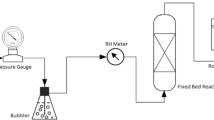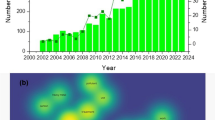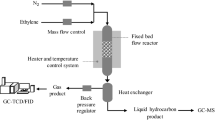Abstract
This work reports the syntheses of an inexpensive and efficient asphalt-derived mesoporous carbon (AdMC) as an adsorbent. The adsorbent was activated with potassium hydroxide to increase its surface area and then characterized by SEM–EDS, FT-IR, and BET. The adsorption properties of AdMC were evaluated for the adsorptive removal of eleven Poly Aromatic Hydrocarbons (PAHs) and diesel from water samples. The prepared AdMC showed very high surface areas and high micropore volumes equal to 2316 m2/g and 1.2 cm3/g, respectively. Various experimental conditions influencing the adsorption capacity of eleven PAHs and diesel were investigated. At high concentrations, PAHs and diesel solubility in water is very low. Hence, samples were emulsified with a surfactant, and then maximum adsorption capacity was investigated. Adsorption profile of individual PAHs was examined using gas chromatography/mass spectrometry analysis followed by liquid–liquid extraction. Total hydrocarbon removal was studied using a total organic analyzer. Asphalt-derived mesoporous sorbent showed an extreme ability to remove PAHs and diesel (average adsorption capacity of 166 mg/g for individual PAHs and diesel (maximum capacity of 1600 mg/g). The experimental results fitted the Langmuir model with a correlation efficiency of 0.9853. The results obtained for both adsorbents also matched to pseudo-second-order kinetics, suggesting that the adsorption of PAHs and diesel is chemical, monolayer, and homogeneous process.










Similar content being viewed by others
References
Srivastava P, Sreekrishnan TR, Nema AK (2018) Polyaromatic hydrocarbons: review of a global environmental issue. J Hazard Toxic Radioact Waste 22:04018004. https://doi.org/10.1061/(asce)hz.2153-5515.0000391
Srogi K (2007) Monitoring of environmental exposure to polycyclic aromatic hydrocarbons: a review. Environ Chem Lett 5:169–195. https://doi.org/10.1007/s10311-007-0095-0
Chen SJ, Luo XJ, Mai BX, Sheng GY, Fu JM, Zeng EY (2006) Distribution and mass inventories of polycyclic aromatic hydrocarbons and organochlorine pesticides in sediments of the pearl river estuary and the northern South China Sea. Environ Sci Technol 40:709–714. https://doi.org/10.1021/es052060g
Ranjbar Jafarabadi A, Riyahi Bakhtiari A, Yaghoobi Z, Kong Yap C, Maisano M, Cappello T (2019) Distributions and compositional patterns of polycyclic aromatic hydrocarbons (PAHs) and their derivatives in three edible fishes from Kharg coral Island, Persian Gulf, Iran. Chemosphere. https://doi.org/10.1016/j.chemosphere.2018.10.092
Iwegbue CMA, Ogbuta AA, Otutu JO, Obi G, Egobueze FE, Martincigh BS (2019) Evaluation of human exposure to polycyclic aromatic hydrocarbons from some edible oils and shea butter in Nigeria. Polycycl Aromat Compd. https://doi.org/10.1080/10406638.2019.1570951
Sosa D, Hilber I, Faure R, Bartolomé N, Fonseca O, Keller A, Bucheli TD, Escobar A (2019) Polycyclic aromatic hydrocarbons and polychlorinated biphenyls in urban and semi-urban soils of Havana, Cuba. J Soils Sedim 19:1328–1341. https://doi.org/10.1007/s11368-018-2137-6
Liu J, Zhang J, Zhan C, Liu H, Zhang L, Hu T, Xing X, Qu C (2018) Polycyclic aromatic hydrocarbons (PAHs) in Urban Street Dust of Huanggang, Central China: status, sources and human health risk assessment. Aerosol Air Qual Res 19:221–233. https://doi.org/10.4209/aaqr.2018.02.0048
Ncube S, Madikizela L, Cukrowska E, Chimuka L (2018) Recent advances in the adsorbents for isolation of polycyclic aromatic hydrocarbons (PAHs) from environmental sample solutions. TrAC Trends Anal Chem 99:101–116. https://doi.org/10.1016/J.TRAC.2017.12.007
Abdel-Shafy HI, Mansour MSM (2016) A review on polycyclic aromatic hydrocarbons: source, environmental impact, effect on human health and remediation. Egypt J Pet 25:107–123. https://doi.org/10.1016/j.ejpe.2015.03.011
Zhang X, Yu T, Li X, Yao J, Liu W, Chang S, Chen Y (2019) The fate and enhanced removal of polycyclic aromatic hydrocarbons in wastewater and sludge treatment system: a review. Crit Rev Environ Sci Technol. https://doi.org/10.1080/10643389.2019.1579619
Huang Y, Zhang W, Ruan G, Li X, Cong Y, Du F, Li J (2018) Reduced graphene oxide-hybridized polymeric high-internal phase emulsions for highly efficient removal of polycyclic aromatic hydrocarbons from water matrix. Langmuir 34:3661–3668. https://doi.org/10.1021/acs.langmuir.8b00005
Eeshwarasinghe D, Loganathan P, Kalaruban M, Sounthararajah DP, Kandasamy J, Vigneswaran S (2018) Removing polycyclic aromatic hydrocarbons from water using granular activated carbon: kinetic and equilibrium adsorption studies. Environ Sci Pollut Res 25:13511–13524. https://doi.org/10.1007/s11356-018-1518-0
Baird WM, Hooven LA, Mahadevan B (2005) Carcinogenic polycyclic aromatic hydrocarbon-DNA adducts and mechanism of action. Environ Mol Mutagen 45:106–114. https://doi.org/10.1002/em.20095
Rengarajan T, Rajendran P, Nandakumar N, Lokeshkumar B, Rajendran P, Nishigaki I (2015) Exposure to polycyclic aromatic hydrocarbons with special focus on cancer, Asian Pac J Trop Biomed 5:182–189. https://doi.org/10.1016/S2221-1691(15)30003-4
Oranuba E, Deng H, Peng J, Dawsey SM, Kamangar F (2018) Polycyclic aromatic hydrocarbons as a potential source of carcinogenicity of mate. J Environ Sci Health Part C. https://doi.org/10.1080/10590501.2019.1555323
Karacik B, Okay OS, Henkelmann B, Bernhöft S, Schramm KW (2009) Polycyclic aromatic hydrocarbons and effects on marine organisms in the Istanbul Strait. Environ Int 35:599–606. https://doi.org/10.1016/j.envint.2008.11.005
Lamichhane S, Bal Krishna KC, Sarukkalige R (2016) Polycyclic aromatic hydrocarbons (PAHs) removal by sorption: a review. Chemosphere 148:336–353. https://doi.org/10.1016/j.chemosphere.2016.01.036
Chen B, Yuan M, Liu H (2011) Removal of polycyclic aromatic hydrocarbons from aqueous solution using plant residue materials as a biosorbent. J Hazard Mater 188:436–442. https://doi.org/10.1016/J.JHAZMAT.2011.01.114
Xi Z, Chen B (2014) Removal of polycyclic aromatic hydrocarbons from aqueous solution by raw and modified plant residue materials as biosorbents. J Environ Sci 26:737–748. https://doi.org/10.1016/S1001-0742(13)60501-X
Changchaivong S, Khaodhiar S (2009) Adsorption of naphthalene and phenanthrene on dodecylpyridinium-modified bentonite. Appl Clay Sci 43:317–321. https://doi.org/10.1016/j.clay.2008.09.012
Bruna F, Celis R, Real M, Cornejo J (2012) Organo/LDH nanocomposite as an adsorbent of polycyclic aromatic hydrocarbons in water and soil–water systems. J Hazard Mater 225–226:74–80. https://doi.org/10.1016/J.JHAZMAT.2012.04.064
Ceylan D, Dogu S, Karacik B, Yakan SD, Okay OS, Okay O (2009) Evaluation of butyl rubber as sorbent material for the removal of oil and polycyclic aromatic hydrocarbons from seawater. Environ Sci Technol 43:3846–3852. https://doi.org/10.1021/es900166v
Vidal CB, Barros AL, Moura CP, de Lima ACA, Dias FS, Vasconcellos LCG, Fechine PBA, Nascimento RF (2011) Adsorption of polycyclic aromatic hydrocarbons from aqueous solutions by modified periodic mesoporous organosilica. J Colloid Interface Sci 357:466–473. https://doi.org/10.1016/J.JCIS.2011.02.013
Luo Y-B, Cheng J-S, Ma Q, Feng Y-Q, Li J-H (2011) Graphene-polymer composite: extraction of polycyclic aromatic hydrocarbons from water samples by stir rod sorptive extraction. Anal Methods 3:92–98. https://doi.org/10.1039/C0AY00624F
Ho W-L, Liu Y-Y, Lin T-C (2011) Development of molecular imprinted polymer for selective adsorption of benz[a]pyrene among airborne polycyclic aromatic hydrocarbon compounds. Environ Eng Sci 28:421–434. https://doi.org/10.1089/ees.2010.0268
Yang K, Zhu L, Xing B (2006) Adsorption of polycyclic aromatic hydrocarbons by carbon nanomaterials. Environ Sci Technol 40:1855–1861. https://doi.org/10.1021/es052208w
Zhang S, Shao T, Kose HS, Karanfil T (2010) Adsorption of aromatic compounds by carbonaceous adsorbents: a comparative study on granular activated carbon, activated carbon fiber, and carbon nanotubes. Environ Sci Technol 44:6377–6383
Yuan M, Tong S, Zhao S, Jia CQ (2010) Adsorption of polycyclic aromatic hydrocarbons from water using petroleum coke-derived porous carbon. J Hazard Mater 181:1115–1120. https://doi.org/10.1016/J.JHAZMAT.2010.05.130
Qiao K, Tian W, Bai J, Dong J, Zhao J, Gong X, Liu S (2018) Preparation of biochar from Enteromorpha prolifera and its use for the removal of polycyclic aromatic hydrocarbons (PAHs) from aqueous solution. Ecotoxicol Environ Saf 149:80–87. https://doi.org/10.1016/J.ECOENV.2017.11.027
Cheng H, Bian Y, Wang F, Jiang X, Ji R, Gu C, Yang X, Song Y (2019) Green conversion of crop residues into porous carbons and their application to efficiently remove polycyclic aromatic hydrocarbons from water: sorption kinetics, isotherms and mechanism. Bioresour Technol 284:1–8. https://doi.org/10.1016/j.biortech.2019.03.104
Kumar JA, Amarnath DJ, Sathish S, Jabasingh SA, Saravanan A, Hemavathy RV, Anand KV, Yaashikaa PR (2019) Enhanced PAHs removal using pyrolysis-assisted potassium hydroxide induced palm shell activated carbon: batch and column investigation. J Mol Liq 279:77–87. https://doi.org/10.1016/j.molliq.2019.01.121
Eeshwarasinghe D, Loganathan P, Vigneswaran S (2019) Simultaneous removal of polycyclic aromatic hydrocarbons and heavy metals from water using granular activated carbon. Chemosphere 223:616–627. https://doi.org/10.1016/j.chemosphere.2019.02.033
Rodenas M, Amoros D, Solano A (2003) Understanding chemical reactions between carbons and NaOH and KOH An insight into the chemical activation mechanism. Carbon NY 41:267–275
Deng H, Yang L, Tao G, Dai J (2009) Preparation and characterization of activated carbon from cotton stalk by microwave assisted chemical activation—application in methylene blue adsorption from aqueous solution. J Hazard Mater 166:1514–1521. https://doi.org/10.1016/j.jhazmat.2008.12.080
Romanos J, Beckner M, Rash T, Firlej L, Kuchta B, Yu P, Suppes G, Wexler C, Pfeifer P (2012) Nanospace engineering of KOH activated carbon. Nanotechnology. https://doi.org/10.1088/0957-4484/23/1/015401
Saleh TA, Danmaliki GI (2016) Influence of acidic and basic treatments of activated carbon derived from waste rubber tires on adsorptive desulfurization of thiophenes. J Taiwan Inst Chem Eng 60:460–468. https://doi.org/10.1016/j.jtice.2015.11.008
Jalilov AS, Ruan G, Hwang CC, Schipper DE, Tour JJ, Li Y, Fei H, Samuel ELG, Tour JM (2015) Asphalt-derived high surface area activated porous carbons for carbon dioxide capture. ACS Appl Mater Interfaces 7:1376–1382. https://doi.org/10.1021/am508858x
Jalilov AS, Li Y, Tian J, Tour JM (2017) Ultra-high surface area activated porous asphalt for CO2 capture through competitive adsorption at high pressures. Adv Energy Mater 7:1–7. https://doi.org/10.1002/aenm.201600693
Su J, Gao P, Laux SJ, Ma LQ, Townsend TG (2019) Contribution of asphalt products to total and bioaccessible polycyclic aromatic hydrocarbons. Int J Environ Res. https://doi.org/10.1007/s41742-019-00189-6
Burstyn I, Randem B, Lien JE, Langård S, Kromhout H, Bitumen (2002) Polycyclic aromatic hydrocarbons and vehicle exhaust: exposure levels and controls among Norwegian asphalt workers. Ann Occup Hyg 46:79–87. https://doi.org/10.1093/annhyg/mef023
Burstyn I, Boffetta P, Heederik D, Partanen T, Kromhout H, Svane O, Langård S, Frentzel-Beyme R, Kauppinen T, Stücker I, Shaham J, Ahrens W, Cenée S, Ferro G, Heikkilä P, Hooiveld M, Johansen C, Randem BG, Schill W (2003) Mortality from obstructive lung diseases and exposure to polycyclic aromatic hydrocarbons among asphalt workers. Am J Epidemiol 158:468–478. https://doi.org/10.1093/aje/kwg180
McClean MD, Rinehart RD, Ngo L, Eisen EA, Kelsey KT, Wiencke JK, Herrick RF (2004) Urinary 1-hydroxypyrene and polycyclic aromatic hydrocarbon exposure among asphalt paving workers. Ann Occup Hyg 48:565–578. https://doi.org/10.1093/annhyg/meh044
Burstyn I, Kromhout H, Johansen C, Langard S, Kauppinen T, Shaham J, Ferro G, Boffetta P (2007) Bladder cancer incidence and exposure to polycyclic aromatic hydrocarbons among asphalt pavers. Occup Environ Med 64:520–526. https://doi.org/10.1136/oem.2006.029801
USEPA (2007) Method 625—Base/neutrals and acids. https://www.epa.gov/sites/production/files/2015-10/documents/method_625_1984.pdf
Saleh TA, Gupta VK, Al-Saadi AA (2013) Adsorption of lead ions from aqueous solution using porous carbon derived from rubber tires: experimental and computational study. J Colloid Interface Sci 396:264–269. https://doi.org/10.1016/j.jcis.2013.01.037
Saleh TA, Danmaliki GI (2016) Adsorptive desulfurization of dibenzothiophene from fuels by rubber tyres-derived carbons: kinetics and isotherms evaluation. Process Saf Environ Prot 102:9–19. https://doi.org/10.1016/j.psep.2016.02.005
Costa JAS, de Jesus RA, da Silva CMP, Romão LPC (2017) Efficient adsorption of a mixture of polycyclic aromatic hydrocarbons (PAHs) by Si–MCM–41 mesoporous molecular sieve. Powder Technol. https://doi.org/10.1016/j.powtec.2016.12.035
Bhadra BN, Song JY, Lee S-K, Hwang YK, Jhung SH (2018) Adsorptive removal of aromatic hydrocarbons from water over metal azolate framework-6-derived carbons. J Hazard Mater 344:1069–1077. https://doi.org/10.1016/J.JHAZMAT.2017.11.057
Diraki A, Mackey HR, Mckay G, Abdala A (2019) Removal of emulsified and dissolved diesel oil from high salinity wastewater by adsorption onto graphene oxide. J Environ Chem Eng 7(3):103106. https://doi.org/10.1016/j.jece.2019.103106
Acknowledgements
The authors would like to acknowledge the support provided by the Deanship of Scientific Research (DSR) at King Fahd University of Petroleum & Minerals (KFUPM), Dhahran, Saudi Arabia, for funding this work through project number IN171031.
Author information
Authors and Affiliations
Corresponding author
Ethics declarations
Conflict of interest
The authors declare that no conflict of interest.
Additional information
Publisher's Note
Springer Nature remains neutral with regard to jurisdictional claims in published maps and institutional affiliations.
Electronic supplementary material
Below is the link to the electronic supplementary material.
Rights and permissions
About this article
Cite this article
Alissa, F.M., Mohammed, D., Osman, A.M. et al. Synthesis of highly efficient asphalt-based carbon for adsorption of polycyclic aromatic hydrocarbons and diesel from emulsified aqueous phase. Carbon Lett. 30, 555–567 (2020). https://doi.org/10.1007/s42823-020-00126-0
Received:
Revised:
Accepted:
Published:
Issue Date:
DOI: https://doi.org/10.1007/s42823-020-00126-0




